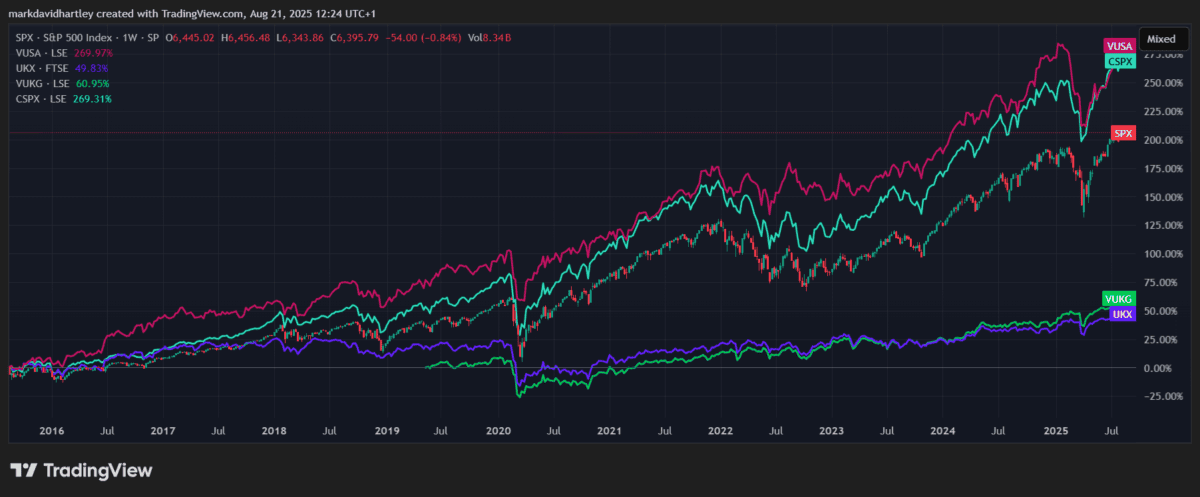
Image source: Getty Images
When people talk about stock market growth, the S&P 500 often dominates the conversation. The US index has been fuelled by world-changing trends over the past decade — artificial intelligence, cloud-computing data centres, and the boom in semiconductor chips that power both.
Unsurprisingly, it has been a golden era for American stocks.
The index is up an impressive 221% in the past 10 years, equating to annualised returns of 12.37% a year. And that doesn’t even include reinvested dividends, which can significantly boost long-term returns. While dividends in the US tend to be lower than in the UK — averaging around 2% — they still add valuable compounding power when reinvested.
Aiming for optimal S&P 500 exposure
The simplest way to capture the full benefit of S&P 500’s growth is through a tracker fund – especially one with accumulating dividends.
Two of the most popular options are the Vanguard S&P 500 ETF (LSE: VUSA) and the iShares Core S&P 500 ETF, both of which have returned around 270% in the past decade.

The Vanguard ETF in particular has become a favourite of many investors. It uses a passive indexing approach, meaning it is market-weighted to try to replicate the S&P 500. Roughly 27% of the fund is concentrated in the top five companies, which include Nvidia, Apple, Microsoft, and Amazon.
One of its biggest attractions is cost. The ongoing charge is just 0.07%, which is tiny compared to actively managed funds. Over the past decade, it has delivered impressive annualised returns of 15.16%.
Of course, there are risks. The ETF is concentrated in US companies, with tech giants dominating. This presents both sector and regional risk. For UK investors, returns are also exposed to currency swings between the pound and the dollar. And like any passive fund, it doesn’t offer any defensiveness in a market crash.
Calculating returns
So how much would a lump sum of £10k have grown in the past decade? If invested in the Vanguard S&P 500 ETF in August 2015, it would now be worth roughly £34,600. That’s the kind of compounding effect billionaire investor Warren Buffett often talks about – steady growth, boosted by reinvested dividends, doing its work over time.
Personally, I think the Vanguard S&P 500 ETF is one of the best ‘set-and-forget’ funds to consider. It gives instant exposure to the entire US market in one simple pick. For newer or passive investors, it saves the headache of analysing individual stocks while avoiding the risk of making bad choices.
That said, an experienced investor with a knack for stock picking could still outperform it by building their own portfolio.
How’s the FTSE 100 doing?
By comparison, the FTSE 100 has been sluggish. A £10,000 investment in the UK’s benchmark index would have grown just 33% in the past decade. However, dividends make a world of difference here. Using an accumulating FTSE 100 tracker fund, such as the Vanguard FTSE 100 UCITS ETF, the return rises to 61.8%.
That still lags the S&P 500 by a wide margin, but it highlights the power of reinvesting dividends, particularly in a market like the UK where payouts are more generous.
For me, the contrast reinforces why the S&P 500 remains such a powerful engine of wealth creation.









